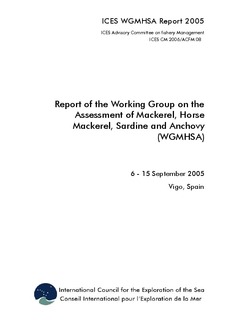| dc.description.abstract | The Working Group on the Assessment of Mackerel, Horse Mackerel, Sardine and Anchovy
(WGMHSA) met in Vigo from 5-16 September, to assess and provide catch options for four
different pelagic species widely distributed in the Northeast Atlantic Ocean. The WG reports
on the status of all 7 stocks (see Fig. 0.1 for stock definitions), and in case of Sardine also on
the status of the species distributed outside current stock definitions. This year a benchmark
analytical assessment is available for Anchovy in Biscay and update analytical assessments
are available for Northeast-Atlantic Mackerel and Sardine in VIIIc and IXa. Western Horse
mackerel is in a benchmark year, so an in-depth exploratory analysis was carried out using
several models (with different assumptions) as well as exploring the signals in the input data.
Southern horse mackerel and Gulf of Cadiz anchovy assessments are still in a developmental
stage, whilst no assessment was possible for North Sea horse mackerel.
Northeast-Atlantic (NEA) Mackerel. This species is distributed in the whole ICES area and
currently supports one of the most valuable European fisheries (with more than 600 kt annual
landings). Mackerel is fished by a variety of fleets (ranging from open boats using hand lines
on the Iberian coasts to large freezer trawlers and Refrigerated Sea Water (RSW) vessels in
the Northern Area. The stock is historically divided into three components, with the North Sea
component considered to be over fished since the late 1970s, and the Western component
contributing the vast majority of biomass and catch to the combined stock. The quality of
sampling data remains good. There is an extensive exploration section examining the trade
offs in assessing the NEA mackerel stock with the available data and model formulations.
This year the issue of accuracy of the catch data has been addressed, and indicates that data on
both the accuracy of landings and estimates of total discards is inadequate. The WG carried
out an update assessment applying the same approach as accepted by ACFM last year. The
assessment indicates that the declining trend of the stock has not continued, but that F in 2004
was above Fpa and outside the management agreement. The exploration exercise concludes
that although the trend in SSB and F and the level of F can be estimated without bias from the
existing data, that the true level of SSB cannot be estimated without knowledge of the level of
unaccounted mortality.Horse Mackerel. Following from the redefinition of the stock boundaries last year, much
work had been carried out intersessionally, in compiling extended data series for western and
southern horse mackerel. For North Sea horse mackerel effort was applied this year to try and
understand why any attempted assessments performed so poorly. The data exploration showed
inconsistent signals in the catch at age data and a survey index, which may be missing an
important component of the stock due to seasonal migration. An in depth exploration was
carried out for western horse mackerel. These analyses showed (with the available data i.e. no
independent measure of stock size), that there had most likely been a change in fishing pattern
in the mid 90’s, that the SSB followed the growth of the exceptional 1982 year class, and that
in 2004 this is at a level around that in 1982. Although large uncertainty surrounds the
estimates of stock parameters, the analyses were more stable and indicated strong recruitment
of the 2001 year class which may have halted the declining trend of the stock. An exploratory
analyses was conducted for southern horsemackerel. This analysis suffers from conflicting
signals between surveys and as for western horse mackerel the absence of an SSB index. None
the less the data exploration indicates a declining SSB since the late 90’s with stable F.
Sardine is assessed only in part of the distribution area: in VIIIc and IXa. Stock structure is
currently under investigation. An update assessment was performed. This assessment showed
a small decrease in the SSB due to the waning influence of the 2000 year class, but that the
SSB is about average. The assessment also indicates a large incoming recruitment (2004 year
class). However even at this level of SSB the stock is more dependent on incoming
recruitment than in the 1980’s. Anchovy is a short-lived species, showing large fluctuations in biomass. This is driven by
recruitment which in turn might be driven by a combination of environmental factors. Catches
consist mainly of 1- and 2-yr old fish. In 2005 there was a failure of the commercial fishery
for the Biscay stock, and this prompted much intercessional work and meetings to be
conducted before the WG. In addition this year the WG attempted a benchmark for Biscay
anchovy, an annual ICA assessment, as performed in previous years, plus a seasonal one are
presented as exploratory assessments, while a Bayesian implementation of the biomass
dynamic model is proposed as the final assessment. There was coherence in the signals in the
catch and survey data and new implementation of the assessment model overcomes some of
the shortcomings of the previous approach. The overall outcome is that SSB is below Blim
and recruitment at age 1 has been low since 2002. Without a recruitment index little can be
said about the prognosis for the stock until the next acoustic and DEPM surveys in late Spring
2006. The assessment of Anchovy in Cadiz is developed further this year with a
standardisation of the CPUE index. This exploratory assessment now gives a coherent picture
of the development of the stock. | en |
